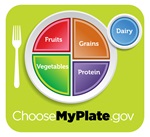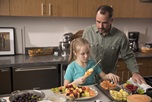In this section
Community partners and professionals
- Child abuse prevention
- Child Advocacy and Protection Services (CAPS)
- Child Welfare Services
- Memberships and accreditation
- Child well-being: Strong Families, Thriving Children
- Resources for schools
- Nutrition ages 2 to 4
- Nutrition ages 5 to 12
- Nutrition 13 and up
- Physical activity ages 2 to 4
- Physical activity ages 5 to 12
- Physical activity 13 and up
- Healthy minds ages 2 to 4
- Healthy minds ages 5 to 12
- Healthy minds 13 and up
Nutrition-ages 5 to 12
Explore fun videos, recipes, interactive mini-lessons and activities to learn more about the basics of nutrition and the importance of healthy eating.
Healthy meals and snacks
Adult supervision is a must when kids are in the kitchen, but getting them involved with cooking or baking can get them excited about trying new foods. Check out the videos and recipes below for ideas and tips for making cooking with kids fun and safe.
The importance of breakfast
Kids who miss breakfast often get hungry later in the day and may graze on less healthy options. If kids don’t eat breakfast, their performance at school can be impacted and they may feel tired, restless or irritable.
A balanced breakfast includes protein and fiber (from fruits, vegetables or whole grains) while trying to keep added sugars to a minimum.
Here are some helpful tips:
- Keep your kitchen stocked with quick and healthy breakfast options.
- Try and get everyone up 10 minutes earlier.
- Prepare as much as you can the night before.
- Have options prepared to take on the go for days when there isn't enough time.
- Be sure to check out the breakfast options available at school as well.
School lunches
Eating a healthy, balanced lunch is important so that kids have energy throughout the day.
- Kids have more freedom during lunch to eat what they like and avoid what they don't. Talk to kids about what to pack in their school lunch or pick out at school, considering the amount of time they have to eat.
- Include whole grains, fruits, vegetables, some meat or protein and dairy in a packed lunch to make sure it's balanced.
- Encourage drinking white milk or water during lunch. Discourage juices and sodas, as they contain a large amount of sugar.
Healthy snacks
Eating too much at snack time can spoil a child's appetite for the next meal. A structured meal and snack schedule is helpful for kids because kids who graze all day have a difficult time figuring out when they are actually hungry.
Snacks should be nutritious. Offer a combination of fiber-rich options (whole grains, fruits and vegetables) and protein-rich options (lean meat, cheese, nuts, or eggs) and offer kids foods that are low in added sugar and salt.
Healthy snack ideas for school age kids include:
- Whole grain pretzels
- Low-fat string cheese
- Fruit smoothies made with Greek yogurt
- Homemade trail mix with whole grain cereal, nuts, and raisins
- Whole grain pita, vegetables, and hummus
MyPlate
 MyPlate is a tool from the USDA that helps teach kids how to eat a balanced, healthy diet.
MyPlate is a tool from the USDA that helps teach kids how to eat a balanced, healthy diet.
- Food groups in MyPlate include: vegetables, fruits, grains, proteins and dairy.
At home, eat a variety of foods at all meals. Try to include at least 3 out of 5 food groups if you can't get all of the groups in. Starting with small changes can be helpful when trying to switch to a healthier lifestyle.
- If your kids have multiple servings of grains in a school lunch such as bread and pretzels, try swapping out one of the grain items for a fruit or vegetable. For example, pack carrots instead of pretzels.
- Add fresh fruit or a salad to dinner if you don't have another fruit or vegetable option such as canned or frozen.
Trying new foods
New food introduction and food variety

Encourage kids to try new foods in a fun, low pressure and calm environment. Introduce the new food first at mealtime. Avoid offering snacks for two hours before eating to make sure kids are hungry. Encourage kids to try new things, but don't set the expectation that they have to eat the whole serving. One bite or even a taste is a success!
Try to avoid making substitutes. If kids learn that they can get an alternative meal if they refuse to eat a food, they will not have incentive to try anything new.
Whenever possible, allow kids to be involved in the process. Ask your kids to help out in the garden, at the grocery store, or in the kitchen. Always be patient, as it can take between 7 and 15 times for kids to like a new food.
Model eating a variety of foods yourself to set a good example!
Tips for picky eaters
If your child isn't hungry, don't try to force them to eat as this can reinforce a power struggle over food.
Serve small portions to help make mealtime more manageable and allow them to ask for seconds.
A routine can help increase a child's appetite during meal times. Keep meals and snacks at least 2 hours apart so kids are hungry at mealtimes.
Be patient, minimize distractions during mealtimes and continue serving healthy food choices until they try them.
Encouraging healthy weight management
What to do:
- Ask questions like "How do you think you could be healthier?" or "What could we do as a family to make better choices?"
- Offer children nutritious food at meals and snacks and allow occasional treats.
- Model eating healthy foods and talk to kids about how they help your body.
- Direct encouragement toward actions a child can control rather than physical appearance. "I'm so glad to see how active you've been this summer!" instead of "Wow, I can tell you've really gotten thinner!"
What not to do:
- Do not brush off or avoid the topic of weight or body image if your child brings it up. Ask open-ended questions to gather more information. There is usually a reason (bullying, peer pressure) they are bringing up the concern in the first place.
- Do not restrict food at meals or promote "dieting." Instead, encourage a structured eating schedule that limits grazing.
- Do not encourage the use of food as a reward. Giving unhealthy food as a reward sends a message that these foods are more valuable or special than healthy ones, a mindset that can stay with a child for life.
Nutrition resources
Resources and online activities
- Click here to download 3-2-1-0 blast off to a healthier you
- Read up on our nutrition food label facts
- Learn more about vegetarian diets by checking out this fact sheet.
- Check out this fact sheet to learn more about sugar.
